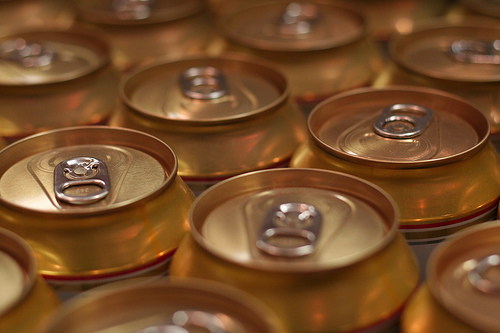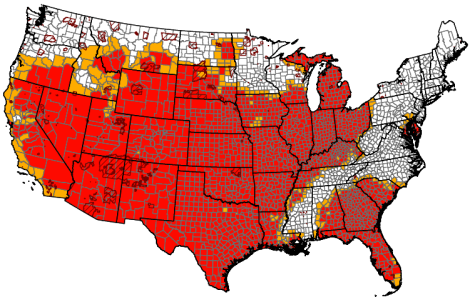We scoff at the primitiveness of our ancient predecessors, coming up with complex theories for the motion of the sun or seeking shelter from the capricious, unpredictable rain. And then we spend all summer discussing global warming or the drought or hurricanes, with all of the effectiveness of scribbling a drawing on the wall with charcoal.
Which brings us to today’s sun and rain update. Or, as I’ve taken to calling it: the 2012 Caveman Report.™
The rain
There was hope that Hurricane Isaac would put a dent in the drought. And, in some areas, that’s been the case.
Several days of rain have given farmers in the nation’s midsection a welcome break from irrigating and hauling water for livestock as they contend with the worst drought in the U.S. in decades.
The remnants of Hurricane Isaac dropped several inches of rain on wide areas of Arkansas, Illinois, Indiana and Missouri as the storm trudged north. Some spots got more than a half-foot of rain.
For most farmers, the rain came too late to make a difference in their year. Corn farmers have been harvesting for weeks, and soybeans are far enough along that the rain won’t significantly improve their quality or growth.
And, of course, the storm also did its own damage, because hurricanes are incorrigible jerks.
In Arkansas, where farmers have been struggling with triple-digit temperatures and little rain, Robby Bevis, 35, saw the storm knock down several of his 150 acres of rice.
Bear in mind, we’re only about halfway through hurricane season. There are currently two Category 2 storms cruising around the Atlantic, though neither appears to be headed for the United States.
[protected-iframe id=”23b2baf16fee973b99bf67e1d3a72f0f-5104299-36375464″ info=”http://www.wunderground.com/wundermap.swf” width=”470″ height=”391″]
(Here’s a satellite photo of Hurricane Michael that’s a jaw-dropper.)
There is one storm brewing in the Gulf of Mexico which could make landfall in the United States: Hurricane Isaac. Yes, that same incorrigible jerk.
Now, a remnant of Isaac has shifted into the Gulf of Mexico, approaching the location of its previous life as a hurricane in the Gulf of Mexico, with thunderstorms persisting.
Bottom line…there is a chance this “piece of the former Isaac” could regenerate into a tropical depression, or perhaps weak tropical storm, over the next 1-2 days in the central Gulf.
It’s unlikely — though in 2004, Hurricane Ivan douple-dipped, hitting Alabama as a Category 3 and then looping around to hit Louisiana as a tropical depression. Ivan was an overachiever. Isaac isn’t expected to be quite as energetic.
The sun
It seems like it has been forever since we talked about the drought (besides a few paragraphs up). This is certainly in part because there wasn’t much new to say: “Yeah, it’s still ridiculously dry and there are no crops and someone name of Joad was trying to get in touch with you.”
There’s still not much new. This was the map of drought disaster areas a month ago. (All maps via the USDA.)
And here it is from last week.
The number of counties has increased. But disaster areas are something of a trailing indicator — a county can be a disaster area even while the drought recedes. So here’s a map of the actual drought.
Yeah, not really better.
The Times has a story today about one way in which strained water resources are leading to conflict as frackers battle farmers in Colorado for access.
A single [fracking] well can require five million gallons of water, and energy companies are flocking to water auctions, farm ponds, irrigation ditches and municipal fire hydrants to get what they need.
That thirst is helping to drive an explosion of oil production here, but it is also complicating the long and emotional struggle over who drinks and who does not in the arid and fast-growing West. Farmers and environmental activists say they are worried that deep-pocketed energy companies will have purchase on increasingly scarce water supplies as they drill deep new wells that use the technique of hydraulic fracturing. …
“It’s not a level playing field,” said Peter V. Anderson, who grows corn and alfalfa on the parched plains of eastern Colorado. “I don’t think in reality that the farmer can compete with the oil and gas companies for that water. Their return is a hell of a lot better than ours.”
As Andy Revkin notes, the water use between the two contestants is hardly equivalent. Frackers use .1 percent of the state’s total. Farmers use 85.5. Though that brings the strain into sharper relief; the struggle is for small percentages of what would normally be available.
Last week, Business Insider noted another impact of the long-term drought.
Like thousands of other Americans getting stuck with huge repair bills, [homeowner Carol] DeVaughan learned that the intense drought baking much of the country’s lawns, fields and forests this summer has also been sucking the moisture from underground, causing shifting that can lead to cracked basements and foundations, as well as damage aboveground. Repairs often cost tens of thousands of dollars and can even top $100,000, and they are rarely covered by insurance, as shocked homeowners have been discovering.
So let’s summarize. We haven’t learned how to deal with the sun; in fact, we’re making its impacts worse. We are still coming to grips with what happens in the case of extreme rain. And now it turns out that we don’t even have shelter figured out.
Which is why I’m moving to a cave. If anyone has a Zippo I could borrow, I’d be very grateful.





